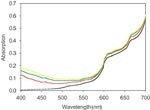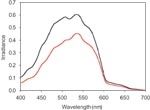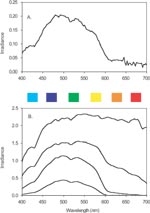PDF of this article (255 KB)

Ian Hawes Clive Howard-Williams
Management of pristine lakes such as Lake Taupo requires an understanding of how the various constituents of natural waters affect their optical properties – water colour and clarity.


Modelled light in Lake Taupo at 10 m depth.
Water colour and clarity are both immediately evident to an observer and important in any assessment of water “quality”. Instinctively we look on clear blue water as better than turbid brown or green water. The clear blue-green water of Lake Taupo, for instance, is enormously valued as part of the pristine character of this lake.
Recent suggestions of a reduction in the clarity of Lake Taupo have rightly set alarm bells ringing. The concern over the deteriorating condition of Lake Taupo has received added attention because of the possibility of extra nutrients entering the lake from changing land use in the catchment. Increased nutrients have the potential to stimulate growth of algae in the water, which, in turn, may reduce clarity and change colour.
To help understand the factors that may be contributing to any clarity reduction of Lake Taupo, recent research (see TAUPEX) has contributed towards building and testing an “Optical Model” of the lake waters. This is a mathematical model that describes the interactions of light with water and substances in the water. Such a model allows us to answer questions about the lake, such as “what would happen to lake colour and clarity if nutrient concentrations rose and caused algal growth in the lake to double?”
Building an optical model
Water colour and clarity are determined by what happens to light when it enters water. The light that we can see – wavelengths of approximately 400 nm (violet) to 700 nm (red) – encounters water molecules as well as suspended and dissolved substances. All of these cause absorption and scattering, the two processes by which light is attenuated (diminished) as it passes through water. We can conveniently divide the constituents of water into four categories:
- water itself;
- coloured dissolved organic matter (CDOM);
- suspended algae (phytoplankton);
- other suspended material.
To construct the optical model we considered the influence of each category on absorption and scattering.
Absorption: Pure water is a strong absorber of red light (long wavelengths), while the CDOM in the water absorbs more blue light (shorter wavelengths). Algae and other particles make a much smaller contribution to absorption. Our measurements for Lake Taupo showed that, at that time, 47% of absorption could be attributed to water, 28% to CDOM, 15% to algae and 10% to other suspended material.
Scattering: Scattering is the deflection of light to a different pathway and depends on the particles in the water more than the dissolved materials or water itself. In Lake Taupo we found that scattering could be linked to the total abundance of algal particles, suggesting that mineral particles make very little contribution.
The absorption and scattering of the individual optical components, referenced to the concentrations of each component where possible, has been included in the optical model for Lake Taupo. This lets us predict the rate of attenuation of light as it passes down through the lake water.
So how clear is Lake Taupo?
A common measure of light attenuation in lake-water is the depth to which 1% of surface light penetrates. This is a useful figure because the 1% level represents just enough light for plants to grow. We can obtain this depth from the optical model, and we can measure it using underwater light meters – the ultimate test of the model.
The 1% light depth measured in the TAUPEX experiment (see TAUPEX) varied from 26 m in the bays to almost 45 m in the centre of the lake. The outputs from the model agreed well with the measured values. This is exceptionally clear water by world lake standards and is due to the low density of particles and the low concentrations of CDOM in Lake Taupo.
What does this mean to the human eye? Visual clarity is how far can you see into the water. A simple measure of clarity is obtained by lowering a Secchi disk (a large white metal disc) into the water and recording the depth at which it disappears from view. Over the week of TAUPEX, the Secchi depth varied between 12 and 20 m. Again the centre of the lake was the clearest. Visual clarity is linked to light attenuation, but tends to be more sensitive to scattering than absorption. The relationship between attenuation and clarity therefore varies over time and between lakes. However, for the period of the experiment we found a close relationship between Secchi disk depth and the 1% light depth. This means that we can begin to approximate visual water clarity from the optical model and thus begin to predict how changes in the lake will affect clarity.
How might colour and clarity change?
The measurements made during TAUPEX allow us to make some preliminary predictions as to how colour and clarity will respond to changes in the lake. For example, if increased nutrient concentrations lead to a doubling algal growth, the model predicts that this will result in a decrease of 17% in water clarity.
Currently the most penetrating light in Lake Taupo is in a broad blue-green band of the spectrum (475–550 nm) (see The colour of Lake Taupo waters). If algal concentrations were to double, the model shows that absorption of light will increase in the blue and green regions, resulting in a shift in dominant colour to the green (540 nm, see graph). Thus Lake Taupo would become visibly greener and slightly more turbid.
As this optical model is developed and refined, we will be in a good position to determine how colour and clarity will change as constituents change. This information will ultimately contribute to management guidelines for maintaining the famous clarity of New Zealand’s largest lake.
Ian Hawes is based at NIWA in Hamilton; Clive Howard-Williams is at NIWA in Christchurch.
TAUPEX
TAUPEX (Transport Assessment and Underwater Profiling Experiment) was a recent international experiment on Lake Taupo. NIWA helped coordinate the project in collaboration with Ngati Tuwharetoa, the Ministry for the Environment, and Environment Waikato. Major goals of TAUPEX were to understand what gives a lake its appearance and to assess how changes may affect future colour and clarity. The May 2002 experiment involved a week of intensive measurements over the whole of Lake Taupo, measuring the concentrations of all of the various optically active components of lake water, and their effects on underwater light. To obtain suitable data for a lake with such clear water as Taupo required the most advanced field optical measuring equipment. For TAUPEX this was provided by NIWA and was also flown in from Canada, the USA and Japan.

The colour of Lake Taupo waters
Water colour differs among lakes because materials in the water affect different wavelengths of light by different amounts. The graphs show irradiance (a measure of light energy) plotted against the wavelengths (colour) of light for Lake Taupo.
Graph A shows the light that is reflected and scattered upwards, separated into its different wavelengths (colours). This is what we see when we look at the lake. Most of the light leaving Lake Taupo is in the 450–550 nm range, making the water appear blue-green.
Graph B shows the light that penetrates downward into the lake and is what would be seen by a diver (or would reach an aquatic plant or animal) underwater. Lines are drawn for irradiance at depths of 1, 3, 10 and 20 metres. The orange-red wavelengths (above 600 nm) are lost most rapidly, so the light at depth is also predominantly blue-green.
